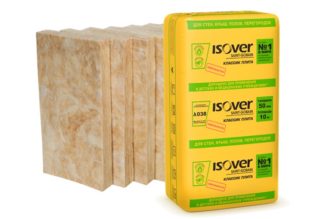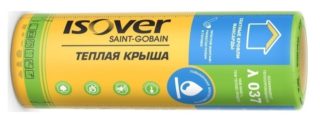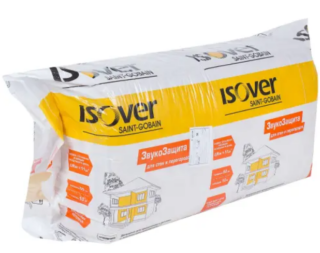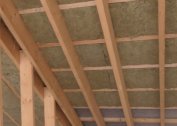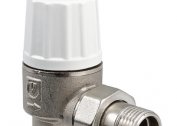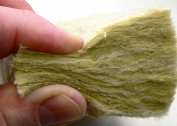Reducing the heat loss of a private house is the main task of a zealous owner. Isover is a heater that has certificates of compliance with Russian building codes. It is produced by the French company Saint Gobain based on mineral fibers obtained from environmentally friendly raw materials. Over decades of production and sales, this material has become a classic in its field of application. The Russian consumer is offered a choice of 8 main types of thermal insulation under one brand.
Scope and characteristics of heat-insulating materials Izover
A qualitative reduction in heat loss involves the insulation of all building envelopes or parts thereof, including internal, external, horizontal, inclined and vertical surfaces. The capabilities of this insulation are not limited to any one direction.
In addition to the main function, this material copes well with sound protection and pipeline insulation. Mineral wool Izover is optimal for thermal insulation of wooden, frame, monolithic or block houses. Resistance to an open flame and high temperature determines its use even in bathhouses or boiler rooms.
Rolled insulation isover has unique technical characteristics:
- thermal conductivity coefficient - 0.040;
- not combustible, environmentally friendly;
- the basis of the composition is quartz filaments;
- the length of the roll, consisting of two mats - 10-11 m;
- width (standard) - 120 cm;
- mat thickness - 50 mm.
Advantages of stone wool:
- resistance to fire;
- resistance to temperature extremes;
- low conductivity of heat and sound;
- simplicity, installation speed;
- elasticity;
- availability.
Disadvantages:
- lack of resistance to moisture;
- the spread of glass dust;
- lack of rigidity.
An interesting feature of this product is its ability to restore shape. During the packaging process, Izover coil insulation is subjected to compression, which reduces its volume by 6 times.
Varieties of Isover and purpose
The manufacturer suggests choosing the type of insulation that meets the specific purpose. Differences of varieties are in appearance, price, characteristics. In Russia, there are 8 popular designs on the market.
Isover Warm House Mats
Isover Warm House is a mineral wool based on quartz fibers. Available in two soft mats twisted into a roll. The thickness of each mat is 50 mm. The area covered when laying in one layer is 13 m2. Apply the product to warm horizontal or inclined surfaces. Optimal for filling the frames of interfloor, attic or basement floors.
Laying inside vertical structures is undesirable, but possible subject to economic and technological justification. In this case, the mats are fixed using transversely stretched strings made of wire or kapron thread.
The material is vapor permeable, but in this case it is more likely a minus than a plus. Under the influence of moisture of mineral wool, Izover loses its heat-insulating properties. An increase in insulation moisture by 1% increases thermal conductivity by 10%. Therefore, the installation of a sealed vapor barrier on both sides of the mats is a mandatory procedure.
Isover Warm Plate House
This is a mineral wool insulation, similar to mats in their properties, but differing in form factor. The main nuance is the elasticity of the material, due to its high density. The design in the form of plates with a size of 610 * 1210 mm simplifies installation and fitting of the frame of the insulated structure.
Plates under the Izover brand are the optimal insulation for walls. Due to their elasticity, they are not inclined to slide down inside the frame; they fit snugly against it. The ability to select the thickness of the insulating layer - 50 or 100 mm - allows you to choose the depth of the crate or counter-crate in the most convenient way.
Isover Pitched Roofing Comfort
These are mats, similar in their properties and purpose to the “Warm House” mats. However, they represent a higher price category, which is justified by distinctive features. The main nuance is the processing of the material by the patented Kraft protective coating. It gives the Izover minplite the following properties:
- reduced coefficient of thermal conductivity - 0.037;
- increased resistance to moisture;
- an almost complete absence of glass dust distributed during installation or operation;
- increased elasticity of the material, simplifying installation inside inclined roofing or vertical wall structures.
Isover Warm Roof
This is Izover rolled insulation, the thickness of which is 100 or 150 mm. It is similar to the "Pitched Roof", but differs in even higher resistance to moisture. This was made possible by applying an additional hydrophobic coating using AquaProtect technology. The main field of application of the material is the insulation of roofs and other building envelopes, the formation of condensation inside of which is not excluded.
Isover Stucco Facade
Plates Isover "Plaster Facade" is a thermal insulation with excellent properties: high density, vapor permeability, hydrophobicity, elasticity, strength. These qualities significantly simplify installation, eliminate excessive moisture saturation and facilitate subsequent finishing.
Scope - wall insulation from the outside, subject to aggressive climate influence. Installation is carried out by fixing the plate type dowels ("umbrellas" or "mushrooms") or gluing with special glue. The hydrophobicity of the plates explains the possibility of finishing them with facade plasters.
Isover Sauna
Foiled mineral wool is additionally protected from temperature and moisture. Aluminum foil allows its use in rooms such as saunas, baths, showers, pools. Vapor permeability in this case is excluded, thermal insulation properties will not decrease. Therefore, installation is carried out in the same way as the installation of other plate heaters, but the use of vapor barrier membranes becomes unnecessary. This material is representative of an even higher price category.
Isover Soundproof
Isover insulation "Soundproofing" is characterized by a minimum density of binding components. Due to this feature, the soundproofing properties of the material are significantly improved while maintaining thermal insulation. However, the laying of plates is somewhat complicated by the need for respect. Nevertheless, the installation of "Soundproofing" inside the frame partitions is also relevant, as well as inside the ceilings.
Isover Floating Floor
These are plates characterized by high density and rigidity. Sound and thermal insulation characteristics remain high. The main function of the plates is to create a barrier to the path of heat and sound inside any frame, monolithic structures. They are used as the basis for the installation of concrete floating screed or under plaster.
A useful difference between the Floating Floor material is the presence of tongue-and-groove end locks that simplify installation and exclude the formation of “cold bridges”.
Mounting Features
When working with Izover material, remember - this is glass wool. Despite the application of additional protective coatings on the surface of certain species, the spread of glass dust is not excluded.Her contact with the skin will only cause temporary irritation, but contact with the eyes or respiratory tract will be a serious problem. Therefore, the use of gloves, masks, respirators, goggles when working with mineral wool is mandatory.
Laying Izover stone wool is a simple, quick and almost waste-free procedure. Installation between the lags inside the interfloor overlap is carried out without the use of additional means of fixation. Inclined roof structures usually also do not require dowels or strings. Vertical installation of rolls can cause some difficulties, therefore it is undesirable. The plates are installed in the partitions between the profiles or bars of the lathing, mounted so that the heater enters as tightly as possible. As a rule, the width between the racks, equal to the width of the slab minus 1 cm, is quite sufficient. Installation of facade samples is carried out using plate-shaped dowels or special glue.




